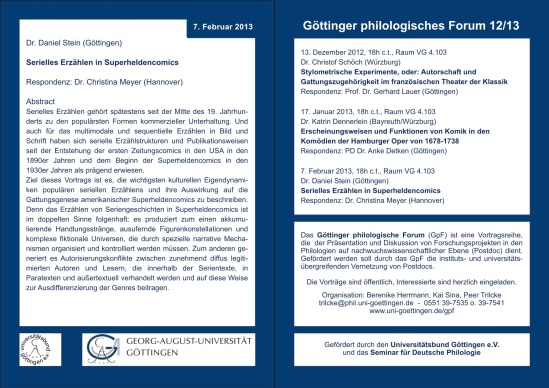
On February 7, 2013, my colleague Daniel Stein will be giving a talk on “Serial Storytelling in Superhero Comics” at the Göttinger philologisches Forum. Click on the flyer above for all the details, contact info, and an abstract.

On February 7, 2013, my colleague Daniel Stein will be giving a talk on “Serial Storytelling in Superhero Comics” at the Göttinger philologisches Forum. Click on the flyer above for all the details, contact info, and an abstract.
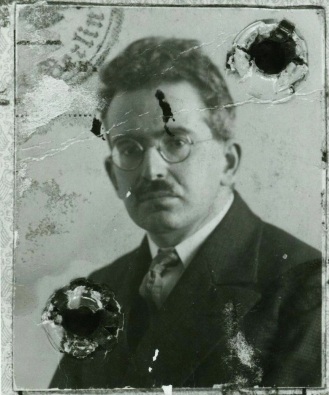
Tomorrow (November 14, 2012), there are two events at the University of Hannover that might be of interest to readers of the blog.
First up, there’s the first meeting this semester of the Film & TV Reading Group (see the flyer here), where we’ll be discussing Walter Benjamin’s famous Artwork essay. We’ll meet from 4 to 6 pm in room 613 (Conti-Hochhaus). The reading group always welcomes new participants, so please spread the word to anyone who might be interested in joining us!
Second, and immediately following the reading group, Frank Kelleter will be giving a talk entitled “Massenkultur, Serienkultur, Populärkultur am Beispiel des Wonderful Wizard of Oz und seiner Variationen” [roughly: Mass Culture, Serial Culture, Popular Culture, with Reference to the Wonderful Wizard of Oz and its Variations]. The talk, from 6 to 8 pm in room 103 (Conti-Hochhaus), will take place in the context of the seminar “Massenkultur: Unterhaltung, Konsum, Medialität” [Mass Culture: Entertainment, Consumption, Mediality], which is being jointly taught by Ruth Mayer and Michael Gamper. Frank Kelleter is professor of American studies in Göttingen and the speaker for the DFG Research Group “Popular Seriality — Aesthetics and Practice” (in which Ruth Mayer and I are collaborating on the project “Serial Figures and Media Change”). He has recently published a chapter entitled “‘Toto, I Think We’re in Oz Again’ (and Again and Again): Remakes and Popular Seriality” in Film Remakes, Adaptations and Fan Productions: Remake / Remodel, edited by Kathleen Loock and Constantine Verevis.

American Comic Books and Graphic Novels is a special issue of Amerikastudien / American Studies (issue 56.4), edited by Daniel Stein and Christina Meyer (my co-editors on the forthcoming Transnational Perspectives on Graphic Narratives: Comics at the Crossroads), together with Micha Edlich from the University of Mainz. The special issue, which I just found in my mailbox, has turned out to be a very nice collection of essays, bringing together theorizations of comics and graphic narratives as a medium or medial form and close readings of specific case studies. Also included is an interview with David Mack, conducted by Henry Jenkins. Daniel Stein has posted the full table of contents at his academia.edu page (here).
My own contribution, “Marvel Comics’ Frankenstein: A Case Study in the Media of Serial Figures,” continues my recent explorations of the nexus of seriality and/as mediality. Here’s the abstract:
This essay argues that Marvel’s Frankenstein comics of the 1960s and 1970s offer a useful case study in the dynamics of serial narration, both as it pertains to comics in particular and to the larger plurimedial domain of popular culture in general. Distinguishing between linear and non-linear forms of narrative seriality—each of which correlates with two distinct types of series-inhabiting characters—I argue that Marvel’s staging of the Frankenstein monster mixes the two modes, resulting in a self-reflexive exploration and interrogation of the comics’ story- telling techniques. Furthermore, I contend that this process sheds light on the medial dynamics of serial figures—that is, characters such as the monster (but also superheroes like Batman and Superman or other figures like Tarzan and Sherlock Holmes) that are adapted again and again in a wide variety of forms, contexts, and media. Though narrative continuity may be lacking between the repeated stagings of serial figures, non-diegetic traces of previous incarnations accumulate on such characters, allowing them to move between and reflect upon medial forms, never wholly contained in a given diegetic world. Accordingly, Marvel’s depiction of the Frankenstein monster leads to a self-reflexive probing of comic books’ forms of narrative and visual mediality, ultimately problematizing the very building blocks of comics as a medium—the textual and graphic framings that, together, narrate comics’ serialized stories.
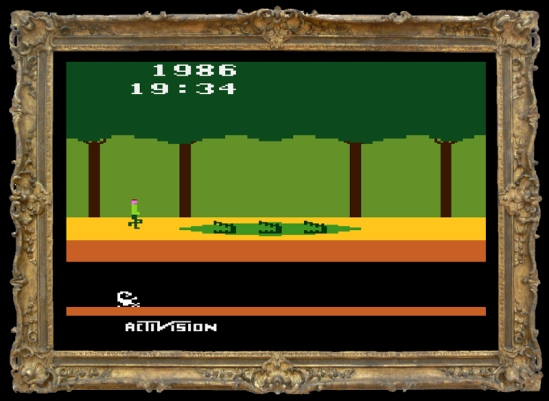
Here’s my position paper for the “Game Studies as Media Studies” panel at the FLOW Conference 2012 in Austin, Texas (November 1-3).
Ludic Serialities and the “Parergodicity” of Game Studies as Media Studies
Shane Denson, Leibniz Universität Hannover
The topic of this panel, “Game Studies as Media Studies,” challenges us to stipulate relations (however tentatively) between two fields of study that are themselves in many ways intersectional, cross-disciplinary, and thus to a certain extent undefined. Indeed, by broaching this topic we are returned to the (self-proclaimed) inaugural moment of game studies: to the debates raging as Espen Aarseth famously announced, in 2001’s premiere issue of the online journal Game Studies, “Year One” of computer game studies. In his attempt to stake out the terrain for “a new discipline” and protect it from “colonising efforts” from film and literary studies, Aarseth declared games’ independence from “old mass media, such as theatre, movies, TV shows and novels.” Already eleven years ago, then, Aarseth rejected the idea of game studies as media studies, writing: “Some would argue that the obvious place for game studies is in a media department, but given the strong focus there on mass media and the visual aesthetics, the fundamentally unique aspects of the games could easily be lost.”
The background, of course, was the so-called narratology-versus-ludology debate. And though that debate has since subsided (to the point, even, that some question whether it ever took place at all; cf. Frasca 2003), many of the central points of contention inevitably arise again when we undertake to reassess the relations between game studies and media studies. The crux, of course, is the ludological idea that the defining feature of games as a medium, and hence the core concern of game studies, is the interactive or, in Aarseth’s (1997) term, “ergodic” situation of gameplay – where ergodics combines the Greek ergon (work) and hodos (path), thus positing nontrivial labor as the aesthetic mode of players’ engagement with games. From a ludological perspective, narrative then appears as marginal, subordinate, or at best supplementary or parallel to gameplay – hence para- or “parergodic,” as I propose calling it. And not just narrative, but many of the aspects that might interest media scholars occupy this marginal or framing field of parergodics: from visual forms on screen, for example, to the social and cultural formations they give rise to in the wider world, outside the games themselves.
But parergodicity, a term which combines Aarseth’s “ergodics” with Derrida’s (1987) “parergon,” is not clearly distinguishable from the core of ergodics; on the contrary, the parergodic enacts a logic of supplementarity, a multistable oscillation such as Derrida ascribes to the picture frame: standing outside the work and serving as its background, the frame can also shift and become part of the figure when seen against the background of the wall. Parergodicity, I propose, defines a broad space for media studies research on games, allowing us more generally to rethink the relations between media studies and game studies so as to avoid both extremes of incommensurability and of colonization: “game studies as media studies,” conceived as a field of parergodic inquiry, aims at once to acknowledge the medial specificity of games, their resistance to paradigms established by studying dominant media like film and TV, without thereby ignoring the many empirical and conceptual points of contact that exist.
A key field of parergodic phenomena that demonstrates this potential is the widespread but undertheorized seriality that characterizes games at virtually every level of their material, cultural, and intermedial expression. While the serialization practices that generate ever new iterations of Mario, Zelda, or Lara Croft might seem to be clearly extraneous to the ergodic activity of gameplay, this is far from obvious. In the context of a joint project entitled “Digital Seriality: The Serial Aesthetics and Practice of Digital Games,” Andreas Jahn-Sudmann and I have identified three levels across which seriality can be seen to resonate. Most basically, seriality informs gameplay directly through formal-algorithmic structures of repetition/variation and the intra-ludic seriality of progressive game “levels” (which often repeat, and vary, the basic representational but also actional structures established in earlier levels, thus establishing both episodic closure and continuation). Sequels, remakes, and other explicit serialization practices constitute inter-ludic serialities that are operative between games, but not without consequence or relation to gameplay proper and its infrastructure (the modularity of game engines promotes inter-ludic serialization, for example, essentially repeating the serial patterning of intra-game levels). Moreover, fan practices and transmedial phenomena beyond the games themselves instantiate extra- or para-ludic serialities, which tie gameplay into larger networks of media consumption and exchange. As parergodic phenomena, ludic serialities therefore cut across the divisions that were taken to separate narratological and ludological positions. Finally, then, these serial structures offer both a broad basis for cross-media comparisons (from dime novels, film serials, TV series, etc.), as well as the means for identifying salient differences of digital interactivity, thus articulating a field of parergodics as the site of overlap, complementarity, and mutual advantage for game studies and media studies.
Works cited:
Aarseth, Espen J. 1997. Cybertext: Perspectives on Ergodic Literature. Baltimore: Johns Hopkins UP.
Aarseth, Espen J. 2001. “Computer Game Studies, Year One.” Game Studies 1.1 (July 2001): <http://www.gamestudies.org/0101/editorial.html>.
Derrida, Jacques. 1987. The Truth in Painting. Trans. Geoff Bennington and Ian McLeod. Chicago: U of Chicago P.
Frasca, Gonzalo. 2003. “Ludologists love stories, too: Notes from a debate that never took place.” Level Up Conference Proceedings. Utrecht: University of Utrecht. 92-99. <http://www.digra.org/dl/db/05163.01125>.
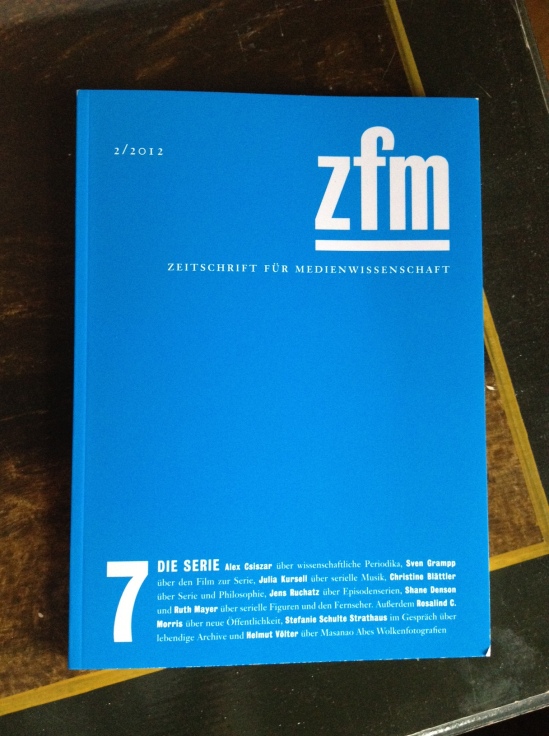
The new issue of Zeitschrift für Medienwissenschaft is out now. It’s a special issue on “The Series,” edited by Daniela Wentz, Lorenz Engell, Jens Schröter, Herbert Schwaab, and Benjamin Beil, and among a great set of articles it includes a piece I co-authored with Ruth Mayer, entitled: “Bildstörung: Serielle Figuren und der Fernseher” [roughly: Image Interference: Serial Figures and the Television]. Here’s the abstract:
This article investigates the logic and aesthetics of popular seriality by looking at several exemplary moments of medial recursivity – which we identify as a ‘motor’ of serial narration and proliferation. Our focus is on the medial development of serial figures – figures that are firmly established in the popular imagination and which have undergone multiple media changes in the course of their careers. In their serial reenactments, these figures are able to shed light on the ways in which the structures of a medial memory are established and updated, and how medial acts of forgetting are operationalized in this context. Exploring three case studies – the figures of Fu Manchu, Fantômas, and Batman – this article in particular reflects on the function of television with respect to its influence on the medial positionings and self-conceptions of other serial entertainment formats (the novel, film). We set out from the hypothesis that television is in many respects privileged in this role as a medium of reference. Not only its propensity for serial forms distinguishes it in this regard, but also its contradictory attributes of immateriality (television viewing) and apparatic presence (the television set) contribute to making the medium of television appear as both the epitome of serial sequentiality and as a disruptive factor or instrument for arresting the flow of serial figures’ stagings – thus covering a broad spectrum of medial reference functions.
And in German:
Dieser Aufsatz untersucht die Logik und Ästhetik populärer Serialität im exemplarischen Bezug auf das Moment der medialen Rekursivität, das hier als ‚Motor’ der seriellen Narration und Proliferation ausgemacht wird. Der Fokus liegt auf der medialen Entfaltung von seriellen Figuren – also Figuren, die in der populären Imagination fest etabliert sind und im Laufe ihrer Karriere mehrere Medienwechsel unterlaufen. In ihrer seriellen Fortschreibung vermögen solche Figuren Aufschluss darüber zu geben, wie Strukturen eines medialen Gedächtnisses etabliert und fortgeschrieben werden und wie mediales Vergessen in diesem Zusammenhang operationalisiert wird. Anhand dreier Fallbeispiele – der Figuren Fu Manchu, Fantômas und Batman – erkundet der Aufsatz insbesondere die Funktion des Leitmediums Fernsehen in seiner Wirkmacht für die mediale Selbstverortung und das Selbstverständnis anderer serieller Unterhaltungsformate (Roman, Spielfilm). Er geht von der Hypothese aus, dass das Fernsehen in vieler Hinsicht für diese Rolle als Referenzmedium privilegiert ist. Nicht nur sein serialitätsaffiner Charakter zeichnet es hierfür aus, sondern auch seine widersprüchlichen Attribute der Immaterialität (Fernsehen) und Apparathaftigkeit (Fernseher) tragen dazu bei, dass dieses Medium gleichermaßen als Inbegriff der seriellen Sequenzialität und als Störfaktor oder Instrument der Arretierung im Fluss der seriellen Figureninszenierung erscheinen kann – und damit ein breites Spektrum an Referenzfunktionen abdeckt.

Just got my copy in the mail today: Populäre Serialität: Narration — Evolution — Distinktion. Zum seriellen Erzählen seit dem 19. Jahrhundert, edited by Frank Kelleter and with contributions from members of the DFG Research Unit “Popular Seriality — Aesthetics and Practice” and others, including Jason Mittell, Oliver Fahle, Lorenz Engell, and more!
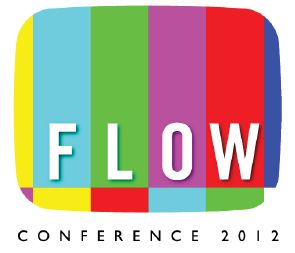
I am pleased to learn that my proposal has been accepted in a panel on “Game Studies as Media Studies” at this year’s FLOW Conference in Austin, Texas (organized biannually by graduate students in the Department of Radio-Television-Film at UT). Interestingly, no papers will be presented at the conference — just five-minute statements followed by panel discussions. The preliminary schedule is now up at the conference website, and for the most part it looks great (though I do regret to see that my panel is scheduled to run concurrently with the panel on “Teaching TV” — I was looking forward to seeing Jason Mittell there, who left Germany a few months ago after his year-long stay in Göttingen; I guess we’ll just have to get a beer afterwards…). Anyway, my proposal is based on a project that I’m currently developing with Andreas Jahn-Sudmann (on “Digital Seriality: The Serial Aesthetics and Practice of Digital Games”). Here’s my short abstract:
Ludic Serialities
Shane Denson
In order to think through the affordances and consequences of conceiving game studies as part of humanities-oriented media studies – as opposed both to non-disciplinary approaches to games as focal objects for many disciplines, as well as to strong disciplinary programs following from “ludological” assertions of digital games’ medial exceptionality – I propose looking at a widespread but undertheorized aspect of video games: viz. the seriality that characterizes games at virtually every level of their material, cultural, and intermedial expression. Seriality informs gameplay through formal-algorithmic structures of repetition/variation and the intra-ludic seriality of progressive game “levels”; sequels, remakes, and other explicit serialization practices constitute inter-ludic serialities; finally, fan practices and transmedial phenomena beyond the games themselves instantiate extra-ludic serialities. Careful attention to serial structures offers both a broad basis for cross-media comparisons (from dime novels, film serials, TV series, etc.), as well as the means for identifying salient differences of digital interactivity.

I’m not teaching any courses right now, but if I were then Steven Shaviro’s “MELANCHOLIA, or the Romantic Anti-Sublime” would definitely be required reading! This is an important essay, and the new open-access journal in which it appears, Sequence: Serial Studies in Media, Film, and Music, is sure to establish itself as an important site of media research. Founded and co-edited by Catherine Grant (of Film Studies for Free fame), the peer-reviewed journal responds to the medial specificities of its digital environment in an innovative — but nevertheless quite “natural” — way: by structuring itself in terms of seriality. From the “About” page:
SEQUENCE will use its position outside of established academic publishing frameworks to work adaptively and responsively, using a sequential edited-collection format – its publication schedule set by its authors and readers, and their research and concerns. In other words, it will make an open-access virtue of its own low-fi, D.I.Y., modular blog format. It can only do this meaningfully, of course, because of the generous labour and research expertise of its authors, and of the editorial and advisory boards of its publisherREFRAME.
Each new scholarly SEQUENCE will begin with the publication of one valuable contribution to research in the fields of media, film or music – on a particular theme named in the issue title. But the editors of each individual SEQUENCE won’t necessarily know what the next in their series will be, or when exactly it will come. Each SEQUENCE could, theoretically, turn out to be ‘infinite’, or only as long as the first, self-contained contribution – a hopefully interesting and worthy, if possibly melancholic, kind of monograph.
In any case, each contribution to a SEQUENCE, and each evolving SEQUENCE as a whole, will go on to be published in a variety of electronic viewing and reading formats, with the web version only the first in a series of digital iterations.
Instead of regularity, we aim above all for spreadability and engagement. Readers will find out about new SEQUENCES, and new contributions and updates to existing SEQUENCES through the paraphernalia and pullulations of contemporary online serial publication: primarily, the project’s blog, its RSS feeds, and its Twitter and Facebook pages, and, hopefully, sharings on from those.
In this spirit, check out Shaviro’s excellent article, share it, and spread the word about this important new venue for online, peer-reviewed, open-access scholarship!
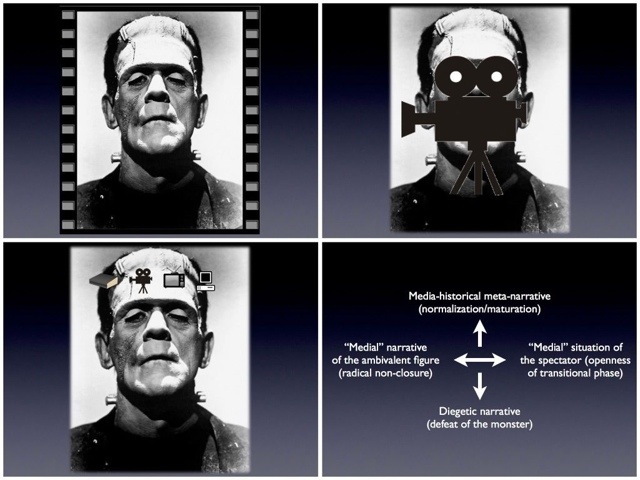
When this post goes online, I’ll be participating in a panel discussion (together with Kathleen Fitzpatrick, Sean O’Sullivan, and Ruth Page, and moderated by Jason Mittell) on the topic of “seriality and media transformations” at the workshop on Popular Seriality going on at the Lichtenberg-Kolleg at the Georg-August-Universität Göttingen. Each of the participants has been asked to prepare a five-minute statement to set the stage and get things rolling. This is what I’ll be saying:
Seriality and Media Transformation
Shane Denson
The topic of this panel, seriality and media transformation, names a constellation of processes that, as I see it, are perhaps not essentially or necessarily linked, but which are nevertheless bound together as a matter of historical fact. I’m tempted to say that seriality and media transformation are “structurally coupled” under conditions of modernity. My thoughts on this topic follow from research I’ve been conducting with Ruth Mayer, where we’ve been looking at popular figures like Frankenstein’s monster, Sherlock Holmes, Tarzan, or Batman – what we call serial figures, which proliferate across a range of media (but in a fragmented, plurimedial way, not by way of the more coherent, and more recent, transmediality that Henry Jenkins describes in terms of “world building”). In the context of this research, where we look at the way these figures jump from one medium to another, perpetually re-creating themselves in the milieu of a new medium, we are concerned with a nexus between seriality and mediality – a nexus where series are not just the contents of specific media (film serials, radio series, TV series, and the like), but where seriality is constituted as a higher-order medium, one in which the relations between and the transformations of first-order media (media as we usually think of them) are put on display, made visible, and negotiated. To make a big claim – because what else can you do in five minutes? – I would claim that it is the very hallmark of modernity to forge and reforge such a nexus of seriality and mediality; in other words, the articulation of seriality as a higher-order medium of media change is a central device for measuring, and indeed for constituting, the progression or forward march of a future-oriented modernity.
So we have to regard the media-historical function of the nexus: Because series unfold over time, they are subject to any changes that their carrier media may undergo. Not just passive receivers, though, series actively trace these transformations as they enact their own temporal unfoldings: the self-historicization by which series mark new installments against the old and in some cases stage qualitative transformations of their internal norms (as when Lost suddenly shifts from using flashbacks to flashforwards) – such processes of serial self-renewal and innovation can also serve as indexes of media change, and as the means for updating the idea of modernity in the process. Modernity itself is all about the update, and more often than not the update in question is all about innovations in media and technologies of mediation. So I’m suggesting that serial forms, which are inherently concerned with perpetually updating themselves, are the “natural” forms in which modernity would seek to stage itself.
Of central importance here is the medial self-reflexivity that serial forms are in various respects capable of instantiating. I’ll just briefly consider the example of Frankenstein’s monster, conceived as a serial figure (or a figure of serialization). Originating in a highly self-reflexive novel about (among other things) the experiential deformations occasioned by industrialization, the monster was serially replicated on the increasingly mechanized theater stages of the nineteenth century, before it became subject, in 1910, of a highly self-reflexive film by the production company of Thomas Edison, the wizard of modern media-technological innovation himself. In the film, as in all the Frankenstein films that would follow in the course of the next century, animation is both a diegetic and a medial process. In 1910, the term “animated pictures” was still used to describe film in general and to distinguish it from the still pictures of photography, so the creation sequence instantiated a sort of “operational aesthetic” in which, against the background of the familiar figure, film could stage itself as a figure of modern media fascination. Importantly, this is at the outset of the cinema’s so-called transitional era, which would radically change the phenomenological and industrial functions of film. Nor is it an accident that the still iconic image of the monster, embodied by Boris Karloff, was established (in 1931) in the wake of the cinema’s sound transition. Robbed of speech, a mute icon served all the better to foreground the fact of sound and thus to stage the self-renewal of film, the updating of the medium’s modernity, against the background of the flat figure’s serialized history. The figure of the monster, which exists not in a series but as a series, which updates itself in color and widescreen formats, in 3-D and CGI, in comics, on TV, and in video games, increasingly becomes a medium itself: a second-order medium of media change, and of modernity as the trajectory of media-technical innovation, updating, and transformation.
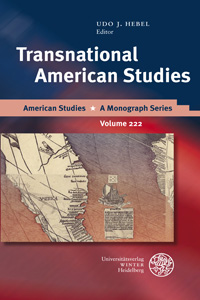
I have yet to hear from anyone at the annual conference of the German Association for American Studies, which is going on now (May 31 – June 3, 2012) in Mainz, but the volume pictured above — Transnational American Studies, edited by Udo Hebel — was scheduled to make its debut there. (The Amazon page is up, but currently listing the book as not yet available.) In any case, I look forward to reading the contributions to the volume, which the publisher (Winter) describes thus:
Transnational approaches and theories have reshaped the interdisciplinary trajectory of American Studies since the turn of the millennium. The further extension of perspectives on the United States and North America to prominently include Atlantic Studies, Hemispheric Studies, and Pacific Studies has complicated long-standing notions of ‘American Studies’ and problematized concepts such as nation, identity, and American exceptionalism.
The collection gathers thirty original contributions to transnational American Studies from the fields of cultural studies, literature, history, politics, and media studies. Individual essays reassess the global role of the U.S. and its perceptions from within and without, discuss how transnational and comparative explorations emphasize multidirectional processes of cultural exchange and transfer, and show how paradigms of migration and cultural mobility have taken definitions and practices of American Studies beyond traditional geographical and disciplinary limits.
Oh, and did I mention that I have a chapter in the book? (Sorry for the self-promotion, but that’s what blogs are for, right?) Anyway, my piece is called “Frame, Sequence, Medium: Comics in Plurimedial and Transnational Perspective,” and it’s a reworking of a talk by the same title that I gave at last year’s DGfA conference. (In case you missed it but are interested, a screencast video of the full presentation can be viewed here.)